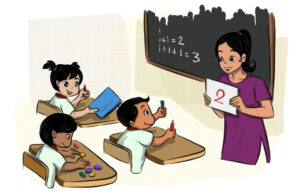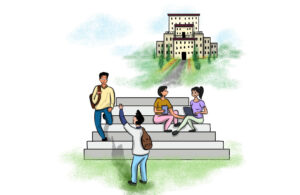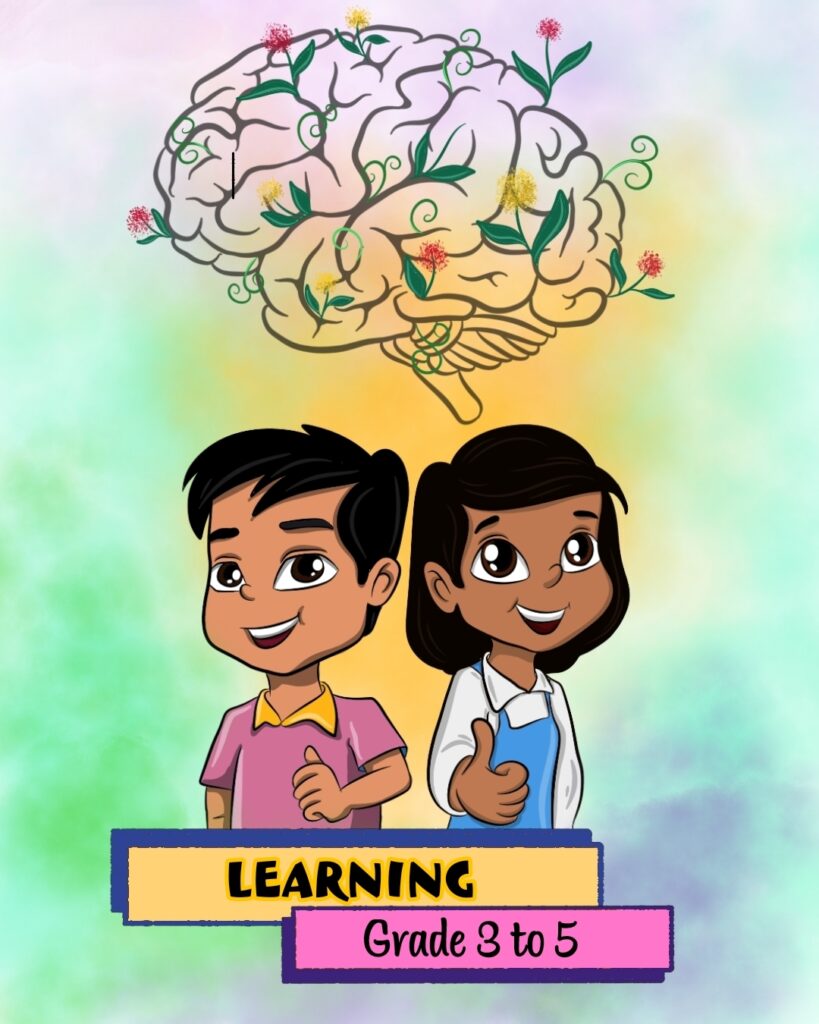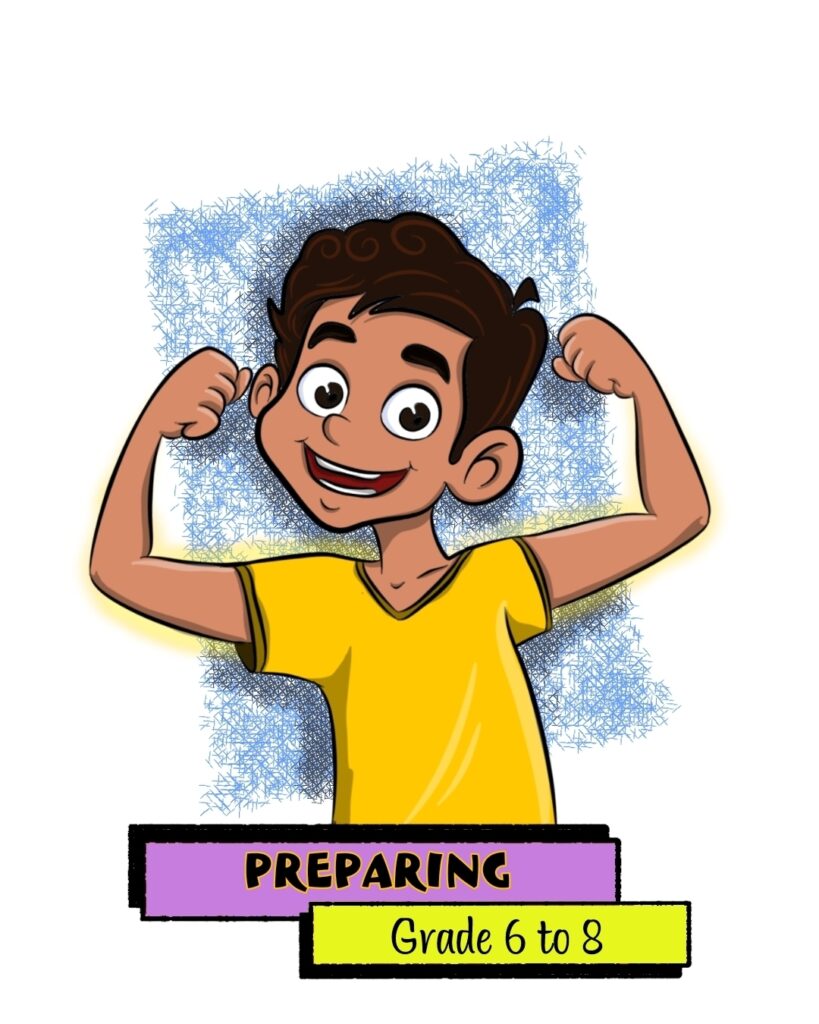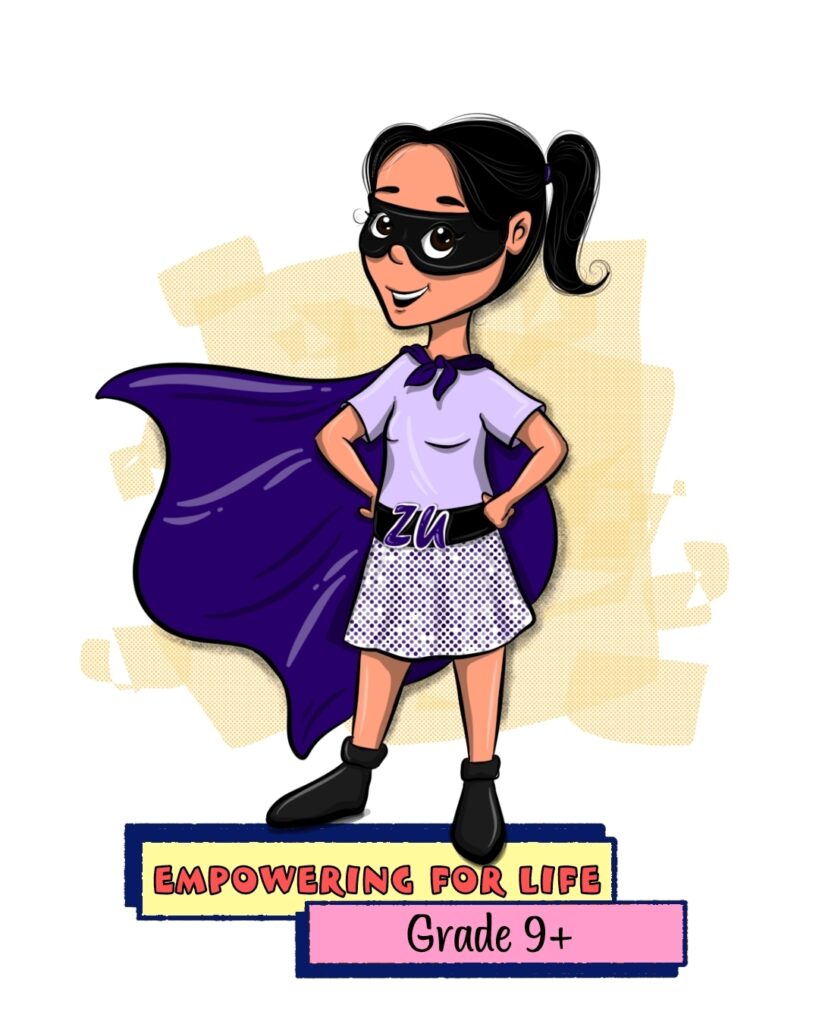Promoting Physical Activity
According to a study published in the Indian Journal of Pediatrics, over 50% of school-aged children in India are physically inactive, with higher rates of inactivity observed among girls. Lack of physical activity can lead to a range of health problems, including obesity, diabetes, cardiovascular disease, and other chronic conditions.
By encouraging children to be active, we can help them develop healthy habits that will serve them well throughout their lives
Teaching about Promoting Physical Activity at a young age helps children in Promoting physical health, Building strong bones and muscles, Improving cognitive function and Developing lifelong habits:
In our classes on Promoting Physical Activity, we teach students to
- Engage in moderate to vigorous physical activity for at least 60 minutes every day.
- Regularly engage in physical activities that enhance cardio-respiratory endurance, flexibility, muscle endurance, and muscle strength.
- Engage in warm-up and cool-down activities before and after structured exercise.
- Follow a physical activity plan for healthy growth and development.
- Avoid injury during physical activity.
- Support others to be physically active.
Each lesson is designed meticulously with the help of global experts, our classes are not only age-appropriate but also culturally appropriate according to the region and state you are watching the classes in. We also customize the classes to fit the requirements of each school.
We follow eight step learning process to ensure life long positive impact on your children.
We are ZatchUp and we are dedicated to empowering your child to make healthy and safe life choices. Thank you
Grade wise learning objective
We follow an 8-step learning process to empower the kids for life. To learn more about our method of teaching, click here.
KG – Grade 2
- Step One: Step one is Understanding the Core Concept : We enable Students to comprehend core concepts related to our all health and safety courses such as consent, violence prevention
- Identify the recommended amount of physical activity for children.
- Explain ways to be active every day, regardless of ability.
- Describe behaviors that are physically active and physically inactive.
- Describe how being physically active can help a person feel better and the importance of selecting appropriate, enjoyable activities.
- Describe the benefits of being physically active, including the physical, social, emotional, academic, and mental health benefits.
- Describe the benefits of drinking plenty of water before, during, and after physical activity.
- Step Two : Second step is to Understand Influences : We enable Students to analyze the influence of family, peers, culture, media, technology, and other factors on their health and Safety.
- Identify how family can influence physical activity practices and behaviors.
- Identify how school can influence physical activity practices and behaviors.
- Identify how media and technology can influence physical activity practices and behaviors.
- Describe positive influences on physical activity practices and behaviors.
- Describe negative influences on physical activity practices and behaviors.
- Step Three : Third step is to learn to access Information : We enable students to access valid information, products, and services to ensure good health and safety.
- Identify trusted adults at home who can help promote physical activity.
- Identify trusted adults and professionals in school (e.g., physical education teacher, coach) who can help promote physical activity.
- Identify trusted adults and professionals in the community (e.g., recreation leader) who can help promote physical activity.
- Explain how to locate school or community health helpers to enhance physical activity.
- Step Four: Fourth step is to learn Interpersonal Communication : We enable students to use interpersonal communication skills to enhance health and reduce all health risks.
- Demonstrate effective refusal skills, including firmly saying “no” and moving away, to avoid engaging in unsafe physical activities.
- Step Five : Fifth step is to learn to make decisions : We enable students to use decision-making skills to enhance healthly behaviour.
- Identify situations that need a decision related to physical activity.
- Describe how family, peers, culture, technology, or media influence a decision related to physical activity.
- Explain how family, peers, or media influence a decision to use proper equipment when engaging in physical activities.
- Explain the potential positive and negative outcomes from decisions related to physical activity.
- Describe when help is needed and when it is not needed to make a healthy decision related to physical activity.
- Step Six : Sixth step is to learn to Set Goals : We enable Students to set the right goals to enhance their health and keep themselves safe.
- Identify a realistic personal short-term goal to be physically active.
- Take steps to achieve the personal goal to be physically active.
- Identify people who can help achieve a personal goal to be physically active.
- Step Seven : Seventh Step is learn Self-Management : We enable students to practice health-enhancing behaviours and reduce health risks.
- Identify practices that reduce inactivity and unsafe physical activity.
- Demonstrate healthy and safe physical activity practices and behaviors.
- Commit to being physically active.
- Step Eight : Eigth step is learn to Advocate : We enable Students to advocate not only for personal, but also for family, and community health.
- Make requests to others (e.g., family members) to promote being physically active.
- Demonstrate how to encourage peers to be physically active.
Grade 3 – Grade 5
- Step One: Step one is Understanding the Core Concept : We enable Students to comprehend core concepts related to our all health and safety courses such as consent, violence prevention
- Describe the recommended amount of physical activity for children.
- Identify ways to increase daily physical activity.
- Identify different types of physical activities.
- Describe the importance of choosing a variety of ways to be physically active.
- Explain positive outcomes for being physically active and the importance of selecting appropriate, enjoyable activities.
- Identify short- and long-term benefits of moderate and vigorous physical activity such as improving mood, self-esteem, attention, cognitive performance, cardiovascular health, strength, endurance, flexibility, and reducing risks for chronic diseases.
- Identify warm up activities to help prevent injury during physical activity.
- Describe the benefits of drinking water before, during, and after physical activity.
- Identify safety precautions for participating in various physical activities in different kinds of weather and climates.
- Identify equipment needed for protection in sports and recreational activities such as mouthpieces, pads, and helmets.
- Step Two : Second step is to Understand Influences : We enable Students to analyze the influence of family, peers, culture, media, technology, and other factors on their health and Safety.
- Identify how culture influences physical activity practices and behaviors.
- Identify how peers influence physical activity practices and behaviors.
- Identify how community influences physical activity practices and behaviors.
- Describe how family and culture influence physical activity practices and behaviors.
- Describe how school and community settings influence physical activity practices and behaviors.
- Describe how media and technology influence physical activity practices and behaviors.
- Describe how peers influence physical activity practices and behaviors.
- Step Three : Third step is to learn to access Information : We enable students to access valid information, products, and services to ensure good health and safety.
- Describe characteristics of valid physical activity information.
- Describe characteristics of valid physical activity products.
- Demonstrate how to locate sources of valid physical activity information.
- Step Four: Fourth step is to learn Interpersonal Communication : We enable students to use interpersonal communication skills to enhance health and reduce all health risks.
- Demonstrate effective verbal and nonverbal communication skills to avoid engaging in unsafe physical activities.
- Explain how to be empathetic and compassionate toward others who are trying to maintain or increase physical activity.
- Demonstrate effective peer resistance skills to avoid or reduce sedentary behaviors.
- Demonstrate how to effectively ask for help to improve personal physical activity.
- Step Five : Fifth step is to learn to make decisions : We enable students to use decision-making skills to enhance healthly behaviour.
- Identify situations that need a decision related to physical activity.
- Decide when help is needed and when it is not needed to make a decision related to physical activity.
- Explain how family, culture, peers, technology, or media influence a decision related to physical activity.
- Identify options and their potential outcomes when making a decision related to physical activity.
- Choose a healthy option when making a decision related to physical activity.
- Describe the final outcome of a decision related to physical activity.
- Step Six : Sixth step is to learn to Set Goals : We enable Students to set the right goals to enhance their health and keep themselves safe.
- Set a realistic personal goal to be physically active.
- Track progress toward achieving a personal goal to be physically active.
- Identify resources that can help to achieve a personal goal to be physically active.
- Step Seven : Seventh Step is learn Self-Management : We enable students to practice health-enhancing behaviours and reduce health risks.
- Describe physical activity practices and behaviors that reduce or prevent health risks.
- Demonstrate healthy physical activity practices and behaviors.
- Commit to being physically active.
- Step Eight : Eigth step is learn to Advocate : We enable Students to advocate not only for personal, but also for family, and community health.
- Give factual information to improve the physical activity of others.
- State personal beliefs to improve the physical activity of others.
- Demonstrate how to persuade others to make healthy physical activity choices.
Grade 6 – Grade 8
- Step One: Step one is Understanding the Core Concept : We enable Students to comprehend core concepts related to our all health and safety courses such as consent, violence prevention
- Describe the recommended amounts and types of moderate, vigorous, muscle strengthening, and bone strengthening physical activity for adolescents and adults.
- Explain how physical activity can be incorporated into daily life without special exercise equipment.
- Describe ways to increase daily physical activity and decrease inactivity.
- Summarize the mental, emotional, and social benefits of physical activity and the importance of selecting appropriate, enjoyable activities.
- Differentiate between physical activity, exercise, health-related fitness, and skill-related fitness.
- Describe physical activities that contribute to maintaining or improving components of health-related fitness.
- Explain the short- and long-term benefits of physical activity including improving mood, self-esteem, attention, cognitive performance, cardiovascular health, strength, endurance, flexibility, and reducing risks for chronic diseases.
- Explain how an inactive lifestyle contributes to chronic disease.
- Explain the importance of warming up and cooling down after physical activity.
- Describe climate-related physical activity conditions that affect physical activity, such as heat exhaustion, sunburn, heat stroke, and hypothermia.
- Summarize the benefits of drinking water before, during, and after physical activity.
- Describe the use of safety equipment for specific physical activities.
- Describe ways to reduce risks of injuries from participation in sports and other physical activities.
- Step Two : Second step is to Understand Influences : We enable Students to analyze the influence of family, peers, culture, media, technology, and other factors on their health and Safety.
- Explain how school rules, community norms, and public health policies or laws (e.g., mandatory PE, bicycling riding laws) influence physical activity practices and behaviors.
- Explain how perceptions of norms influence healthy and unhealthy physical activity practices and behaviors.
- Explain how social expectations influence healthy and unhealthy physical activity practices and behaviors.
- Explain how personal values and beliefs influence physical activity practices and behaviors.
- Describe how some health risk behaviors (e.g., personal health and wellness) influence the likelihood of engaging in physical inactivity practices and behaviors.
- Analyze how family and culture influence physical activity practices and behaviors.
- Analyze how school and community influence physical activity practices and behaviors.
- Analyze how media and technology influence physical activity practices and behaviors.
- Analyze how peers influence physical activity practices and behaviors.
- Step Three : Third step is to learn to access Information : We enable students to access valid information, products, and services to ensure good health and safety.
- Analyze the validity of physical activity information (e.g., differentiate between scientifically or medically accurate content and advertising, including sponsored content).
- Analyze the validity of physical activity products (e.g., sports performance supplements, sports drinks, fitness trackers).
- Analyze the validity of physical activity services (e.g., physical activity classes, personal trainers).
- Determine the availability of valid physical activity products.
- Access valid physical activity information from home, school, or community.
- Step Four: Fourth step is to learn Interpersonal Communication : We enable students to use interpersonal communication skills to enhance health and reduce all health risks.
- Demonstrate the use of effective verbal and nonverbal communication skills to promote physical activity.
- Demonstrate effective peer resistance skills to avoid or reduce sedentary behaviors.
- Demonstrate effective negotiation skills that avoid or reduce participation in unsafe physical activities.
- Demonstrate how to effectively ask for assistance in accessing equipment necessary to safely engage in physical activities.
- Demonstrate how to effectively ask for assistance to improve physical activity.
- Demonstrate how to effectively communicate empathy and support to others who are trying to maintain or improve physical activity.
- Step Five : Fifth step is to learn to make decisions : We enable students to use decision-making skills to enhance healthly behaviour.
- Identify circumstances that help or hinder making a decision to be physically active.
- Determine when situations related to physical activity require a decision (e.g., when a peer suggests watching television, a friend suggests riding bikes without a helmet).
- Distinguish when decisions related to physical activity can be made individually or with the help of others.
- Explain how family, culture, technology, media, peers, and personal beliefs affect a decision related to physical activity.
- Distinguish between healthy and unhealthy alternatives to a decision related to physical activity.
- Predict the potential healthy and unhealthy alternatives to a decision related to physical activity.
- Choose a healthy alternative when making a decision related to physical activity.
- Analyze the effectiveness of a final outcome of a decision related to physical activity.
- Step Six : Sixth step is to learn to Set Goals : We enable Students to set the right goals to enhance their health and keep themselves safe.
- Assess personal physical activity practices.
- Set a realistic personal goal to be physically active.
- Assess the barriers to achieving a personal goal to be physically active.
- Apply strategies to overcome barriers to achieving a personal goal to be physically active.
- Use strategies and skills to achieve a personal goal to be physically active.
- Step Seven : Seventh Step is learn Self-Management : We enable students to practice health-enhancing behaviours and reduce health risks.
- Explain the importance of being responsible for being physically active.
- Analyze personal practices and behaviors that reduce or prevent sedentary behavior.
- Demonstrate healthy practices and behaviors to improve the physical activity of oneself and others.
- Commit to being physically active.
- Step Eight : Eigth step is learn to Advocate : We enable Students to advocate not only for personal, but also for family, and community health.
- State a health-enhancing position about being physically active, supported with accurate information, to improve the health of others.
- Persuade others to make healthy and safe physical activity choices.
- Collaborate with others to advocate for individuals, families, and schools to be physically active.
- Demonstrate how to adapt a positive physical activity messages for different audiences.
Grade 9 – Grade 12
- Step One: Step one is Understanding the Core Concept : We enable Students to comprehend core concepts related to our all health and safety courses such as consent, violence prevention
- Analyze how an inactive lifestyle contributes to chronic disease.
- Analyze ways to increase physical activity and decrease inactivity.
- Summarize the mental, emotional, and social benefits of physical activity and the importance of selecting appropriate, enjoyable activities.
- Summarize the recommended amounts and types of moderate, vigorous, muscle strengthening, and bone strengthening physical activity for adolescents and adults.
- Summarize how a person can incorporate physical activity into daily life without relying on a structured exercise plan or special equipment.
- Differentiate between various sports and physical activities in terms of health and skill-related fitness.
- Evaluate the short- and long-term benefits of physical activity including improving mood, self-esteem, attention, cognitive performance, cardiovascular health, strength, endurance, flexibility, and reducing risks for chronic diseases.
- Summarize physical activities that contribute to maintaining or improving components of health-related fitness.
- Describe methods for avoiding and responding to climate-related physical conditions during physical activity.
- Summarize the importance of warming up before and cooling down after physical activity.
- Explain ways to reduce the risk of injuries from participation in sports and other physical activities.
- Describe the effects of hydration and dehydration on physical performance.
- Determine the necessary protective gear for wheel sports and activities including biking, inline skating, riding a scooter, and skateboarding.
- Describe the use of safety equipment for specific physical activities.
- Step Two : Second step is to Understand Influences : We enable Students to analyze the influence of family, peers, culture, media, technology, and other factors on their health and Safety.
- Explain how public health policies influence physical activity practices and behaviors.
- Analyze how culture supports and challenges physical activity beliefs, practices, and behaviors.
- Analyze how peers and perceptions of norms influence healthy and unhealthy personal physical activity practices and behaviors.
- Analyze how personal attitudes, values, and beliefs influence healthy and unhealthy physical activity practices and behaviors.
- Analyze how some health risk behaviors influence the likelihood of engaging in physical activity practices and behaviors (e.g., personal health and wellness).
- Analyze how laws, rules, and regulations (e.g., transportation) influence physical activity practices and behaviors.
- Analyze how school and community settings influence physical activity practices and behaviors.
- Analyze how media and technology influence personal, family, and community physical activity practices and behaviors.
- Differentiate relevant influences, including family, culture, peers, school, community, media, technology, and public health policies on personal physical activity practices and behaviors.
- Analyze the factors that influence opportunities to obtain safe, accessible, equitable, and affordable products and services that support physical activity practices and behaviors for oneself and others.
- Step Three : Third step is to learn to access Information : We enable students to access valid information, products, and services to ensure good health and safety.
- Evaluate the validity of physical activity information (e.g., differentiate between scientifically or medically accurate content and advertising, including sponsored content).
- Evaluate the validity of physical activity products (e.g., sports performance supplements).
- Evaluate the validity of physical activity services.
- Determine the accessibility of valid physical activity products.
- Determine when professional physical activity services may be required.
- Determine the accessibility of valid physical activity services.
- Use resources that provide valid physical activity information.
- Use valid physical activity products when needed or appropriate.
- Use valid physical activity services when needed or appropriate.
- Step Four: Fourth step is to learn Interpersonal Communication : We enable students to use interpersonal communication skills to enhance health and reduce all health risks.
- Demonstrate effective communication skills to enhance physical activity.
- Demonstrate effective peer resistance, negotiation, and collaboration skills to avoid being sedentary.
- Demonstrate how to effectively ask for assistance to improve physical activity.
- Demonstrate how to effectively ask for assistance to safely use physical activity equipment (e.g., weight lifting equipment).
- Demonstrate how to effectively offer assistance or improve the physically activity of others.
- Step Five : Fifth step is to learn to make decisions : We enable students to use decision-making skills to enhance healthly behaviour.
- Examine barriers to making a decision to be physically active.
- Determine the value of applying thoughtful decision making to a situation related to physical activity.
- Justify when individual or collaborative decision making is appropriate regarding a situation related to physical activity.
- Analyze how family, culture, technology, media, peers, and personal beliefs affect a decision related to physical activity.
- Generate alternatives when making a decision related to physical activity.
- Predict the potential short- and long-term consequences of alternatives to decisions related to physical activity.
- Choose a healthy alternative when making a decision related to physical activity.
- Evaluate the effectiveness of decisions related to physical activity.
- Step Six : Sixth step is to learn to Set Goals : We enable Students to set the right goals to enhance their health and keep themselves safe.
- Assess personal physical activity practices and behaviors.
- Set a realistic personal goal to be physically active.
- Assess the barriers to achieving a personal goal to be physically active.
- Develop a plan to attain a personal goal of being physically active.
- Implement strategies, including self-monitoring (e.g., a personal activity log), to achieve a personal goal of being physically active.
- Use strategies to overcome barriers to achieve a personal goal to be physically active.
- Formulate a long-term personal health plan to achieve a personal goal to be physically active.
- Step Seven : Seventh Step is learn Self-Management : We enable students to practice health-enhancing behaviours and reduce health risks.
- Analyze the role of individual responsibility for being physically active.
- Evaluate personal practices and behaviors that reduce or prevent sedentary behavior.
- Demonstrate healthy practices and behaviors to improve the physical activity of oneself and others.
- Commit to being physically active.
- Step Eight : Eigth step is learn to Advocate : We enable Students to advocate not only for personal, but also for family, and community health.
- Use peer and societal norms, based on accurate health information, to formulate a message that promotes physical activity.
- Persuade and support others to make healthy and safe physical activity choices.
- Collaborate with others to advocate for improving personal, family, and community physical activity.
- Encourage school and community environments to promote the physical activity of others.
- Adapt physical activity health messages and communication techniques for a specific target audience.
- Persuade school and community leaders about the importance of ensuring there are safe, accessible, equitable, and affordable physical activity opportunities, products, and services to improve the health of oneself and others.

